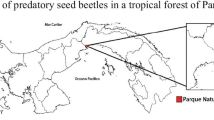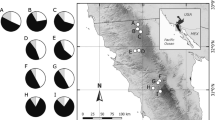Abstract
The licuri palm, Syagrus coronata (Martius) Beccari (Arecaceae), is widely distributed throughout the Brazilian Caatinga and has high cultural, socioeconomical, and ecological importance. The palm tree logging is prohibited by the Brazilian law, and thus isolated individuals are a common sight on managed pastures in the Brazilian semi-arid region. We aimed to compare the insect seed-predator Pachymerus nucleorum (Fabricius) (Bruchinae) abundance and its predation levels on S. coronata seeds between managed (pasture) and natural (Caatinga vegetation) habitats. We also monitored the parasitoid Heterospilus prosopodis (Viereck) (Braconidae) abundance and other P. nucleorum potential natural enemies (generalist predators and microhymenopterans). We tested the hypothesis that more complex and heterogenous habitats (i.e., with higher plant diversity) support higher abundance of potential P. nucleorum natural enemies. For such, we collected 600 fruits from each habitat and evaluated the seed predation level by P. nucleorum, as well as the P. nucleorum parasitism by H. prosopodis. The P. nucleorum abundance and its potential natural enemies were estimated using 122 sticky traps placed on the S. coronata individuals’ crown. Neither the P. nucleorum and generalist predators abundance differed between habitats, whereas the H. prosopodis and microhymenopterans abundance was higher in the natural habitat. Consequently, P. nucleorum parasitism levels by H. prosopodis were also higher in the natural habitat. Our study indicated that habitat with higher plant diversity supported more natural enemies, thus confirming that increased habitat homogenization leads to decreased parasitism levels by the less parasitoids number in managed habitats. Our results may subsidize conservationist management practices in the managed habitats aiming to improve fruit exploitation techniques sustainability and land-use practices, which would thereafter allow for the S. coronata population conservation in the Brazilian Caatinga.


Similar content being viewed by others
References
Altieri MA (2002) Agroecology: the science of natural resource management for poor farmers in marginal environments. Agric Ecosyst Environ 93:1–24
Alves VP, Santos DB, Silva APS (2014) Análise dos recursos hídricos no assentamento Jiboia, município de Senhor do Bonfim-BA. Rev Ouricuri 4:1–31
Andrade MB, Esteves-Filho AB, Siqueira ITD, Giorgi JA (2013) Registro de Pachymerus nucleorum (Fabricius) (Coleoptera, Chrysomelidae, Bruchinae) predando sementes de Licuri em Caetés, Pernambuco, Brasil. Entomo Brasilis 6:239–241
Andrade WM, Ramos MA, Souto WMS, Bento-Silva JS, Albuquerque UP, Araújo EL (2015) Knowledge, uses and practices of the licuri palm (Syagrus coronata (Mart.) Becc.) around protected areas in northeastern Brazil holding the endangered species Lear’s Macaw (Anodorhynchus leari) the northeast Brazil. Trop Conserv Sci 8:893–911
Aroucha EPTL, Aroucha ML (2013) Boas práticas de manejo para o extrativismo sustentável do licuri. Instituto Sociedade, População e Natureza. Brasília, p 92
Barbosa CM (2016) Atributos florais e reprodutivos de Syagrus coronata (Mart) Becc. Como ferramentas para a conservação de uma palmeira endêmica do Brasil. Dissertation – Biologia Vegetal, Universidade Federal de Pernambuco, Recife, p 66.
Begg GS, Cook SM, Dye R, Ferrante M, Franck P, Lavigne C, Lövei GL, Mansion-Vaquie A, Pell JK, Petit S, Quesada N, Ricci B, Wratten SD, Birch ANE (2017) A functional overview of conservation biological control. Crop Prot 97:145–158
Brévault T, Clouvel P (2019) Pest management: reconciling farming practices and natural regulations. Crop Prot 11:1–6
Diebel J, Norda J (2013) Weatherspark, Cedar lake ventures Inc. http://weatherspark.com/ Accessed 05 Jun 2019.
Drumond MA (2007) Licuri Syagrus coronata (Mart.) Becc. Embrapa-Semiárido, Petrolina, p 16
Galetti M, Bovendorp RS, Guevara R (2015) Defaunation of large mammals leads to an increase in seed predation in the Atlantic forests. Glob Ecol Conserv 3:824–830
Garcia AH, Rosa JAM, Costa MGG (1980) Contribuição ao conhecimento do ataque de Pachymerus nucleorum Fabr., 1792 (Bruchidae: Coleoptera) em Syagrus oleraceae Mart. (Palmae). Anais Esco Agro Vet 10:5–11
Gibinski R, Krupek RA (2016) Influência de diferentes fatores sobre a predação de sementes de Araucaria angustifolia (Bertol.) O. Kuntze. Acta Biol Catarinense 3:60–68
Giroldo AB, Scariot A (2015) Land use and management affects the demography and conservation of an intensively harvested Cerrado fruit tree species. Biol Conserv 191:150–158
Grenha VMMV, Macdedo MV, Monteiro RF (2008) Predação de sementes de Allagoptera arenaria (Gomes) O’ Kuntze (Arecaceae) por Pachymerus nucleorum Fabricius. (Coleoptera, Chrysomelidae, Bruchinae). Rev Bras Entomol 52:50–56
Haddad NM, Crutsinger GM, Gross K, Haarstad J, Knops JM, Tilman D (2009) Plant species loss decreases arthropod diversity and shifts trophic structure. Ecol Lett 12:1029–1039
IBAMA (2008) Instrução Normativa n° 191. http://www.ibama.gov.br/ Accessed 20 Feb 2016.
Klein AM, Steffan-Dewenter I, Buchori D, Tscharntke T (2002) Effects of land-use intensity in tropical agroforestry systems on flower-visiting and trap-nesting bees and wasps. Conserv Biol 16:1003–1014
Lorenzi H, Souza HM, Cerqueira LSC, Costa JTM, Ferreira E (2004) Palmeiras brasileiras e exóticas cultivadas. Nova Odessa: Instituto Plantarum v.1, São Paulo, p 416.
Maia DP (2013) Interação tritrófica entre Pachymerus cardo (Fåhraeus), Pachymerus Nucleorum (Coleoptera, Chrysomelidae, Bruchinae) e seus parasitoides em populações de Syagrus romanzoffiana (Cham.) Glassman (Arecaceae). Dissertation - Parasitologia, Universidade Estadual de Campinas, Campinas, p 50.
McCullagh P, Nelder JA (1989) Generalized linear models (2ed.). Chapman and Hall, New York, p 511
Medeiros BASD, Núñez-Avellaneda LA, Hernandez AM, Farrell BD (2019) Flower visitors of the licuri palm (Syagrus coronata): brood pollinators coexist with a diverse community of antagonists and mutualists. Biol J Linn Soc 126:666–687
Moura JIL, Grenha G, Pinto SS, Tavares AM (2009) Danos causados por Pachymerus nucleorum (Coleoptera: Chrysomelidae) a sementes de dendezeiro. Agrotrópica 21:205–206
Noblick LR (2017) A revision of the genus Syagrus (Arecaceae). Phytotaxa 294:001–262
Novais SMA, Macedo-Reis LE, DaRocha WD, Neves FS (2016) Effects of habitat management on different feeding guilds of herbivorous insects in cacao agroforestry systems. Int J Trop Biol Conserv 64:763–777
Novais SMA, Macedo-Reis LE, Neves FS (2017) Predatory beetles in cacao agroforestry systems in Brazilian Atlantic forest: a test of the natural enemy hypothesis. Agrofor Syst 91:201–209
Peach DAH, Gries R, Zhai H, Young N, Gries G (2019) Multimodal floral cues guide mosquitoes to tansy inflorescences. Sci Rep 9:3908
Pereira, CJ (2019) Consequências de distúrbio do habitat sobre o destino de sementes e demografia populacional do licuri (Syagrus coronata) no semiárido baiano. Dissertation - Ecologia e Evolução, Universidade Estadual de Feira de Santana, Feira de Santana, p 49.
R Development Core Team (2016) R: A Language and Environment for Statistical Computing. R Foundation for Statistical Computing, Vienna http://www.R-project.org Accessed 27 Nov 2016
Raguso AR, Willis MA (2005) Synergy between visual and olfactory cues in nectar feeding by wild hawkmoths, Manduca sexta. Anim Behav 69:407–418
Ramalho CI (2006) Licuri (Syagrus coronata). http://wwwccaufpbbr/lavouraxerofila/pdf/licuripdf Accessed (05 Aug 2018)
Ramalho CI (2008) Estrutura da vegetação e distribuição espacial do licuri (Syagrus coronata (Mart.) Becc) em dois municípios do centro norte da Bahia, Brasil. PhD thesis- Agronomia, Universidade Federal da Paraíba, Areia, p 131.
Rocha KMR (2009) Biologia reprodutiva da palmeira Licuri (Syagrus coronata (Mart.) (Becc.) (Arecaeae) na ecoregião do Raso da Catarina, Bahia. Dissertation - Ciências Florestais, Universidade Federal Rural de Pernambuco, Recife, p 98.
Root RB (1973) Organization of a plant-arthropod association in simple and diverse habitats: the fauna of collards (Brassica oleracea). Ecol Monogr 43:95–124
Sá D, Scariot A, Ferreira JB (2018) Effects of ecological and anthropogenic factors on population demography of the harvested Butia capitata palm in the Brazilian Cerrado. Biodivers Conserv. https://doi.org/10.1007/s10531-018-1669-9 Accessed 18 Dec 2018
Silva JO, Oliveira KN, Santos KJ, Espírito-Santo MM, Neves FS, Faria ML (2010) Efeito da estrutura da paisagem e do genótipo de Eucalyptus na abundância e controle biológico de Glycaspis brimblecombei Moore (Hemiptera: Psyllidae). Neotrop Entomol 39:91–96
Silva JMC, Leal IR, Tabarelli M (2017) Caatinga the largest tropical dry forest region in South America. Springer International Publishing, Cham, p 482
Sperber CF, Kakayama K, Valverde MJ, Neves FS (2004) Tree species richness and density affect parasitoid diversity in cacao agroforestry. Basic Appl Ecol 5:241–251
Togni PHB, Venzon M, Souza LM, Santos JPCR, Sujii ER (2019) Biodiversity provides whitefly biological control based on farm management. J Pest Sci 92:393–403
Acknowledgements
We thank MV Morgado, ML Júnior, and CJ Pereira for field assistance. Finally, we thank the laboratory Núcleo de Ecologia e Conservação da Caatinga—NECC and Microbiology from UNIVASF for all the physical structure and logistical support. We thank Cibele Stramare Ribeiro Costa of the Laboratory of Systematic and Bioecology of Coleoptera (Insecta) of the Federal University of Paraná by Bruchinae beetle identification, and André Nascimento of the Universidade Estadual de Campinas-UNICAMP for the support in the H. prosopodis parasitoid identification.
Funding
This study was financed in part by the Coordenação de Aperfeiçoamento de Pessoal de Nível Superior—Brasil (CAPES)—Finance Code 001.
Author information
Authors and Affiliations
Contributions
JOS, MLEC, PMSR, and EMFLS planned the research; MLEC, JOS, BSP, and JSBM conducted samplings; JOS, MLEC, and PMRS analyzed data and conducted statistical analyses; JOS, MLEC, PMRS, JSBM, and EMFLS wrote the manuscript; and JOS, PMRS, and BSP read, suggest, and approved the manuscript during revision.
Corresponding author
Additional information
Edited by Tiago C da Costa Lima – Embrapa
Publisher’s Note
Springer Nature remains neutral with regard to jurisdictional claims in published maps and institutional affiliations.
Rights and permissions
About this article
Cite this article
Silva, J.O.S., Costa, M.L.E., Paixão, B.S. et al. Natural Vs Managed Habitat: Effect Over the Seed-Predator Pachymerus nucleorum and Its Natural Enemies. Neotrop Entomol 49, 131–138 (2020). https://doi.org/10.1007/s13744-019-00727-z
Received:
Accepted:
Published:
Issue Date:
DOI: https://doi.org/10.1007/s13744-019-00727-z




